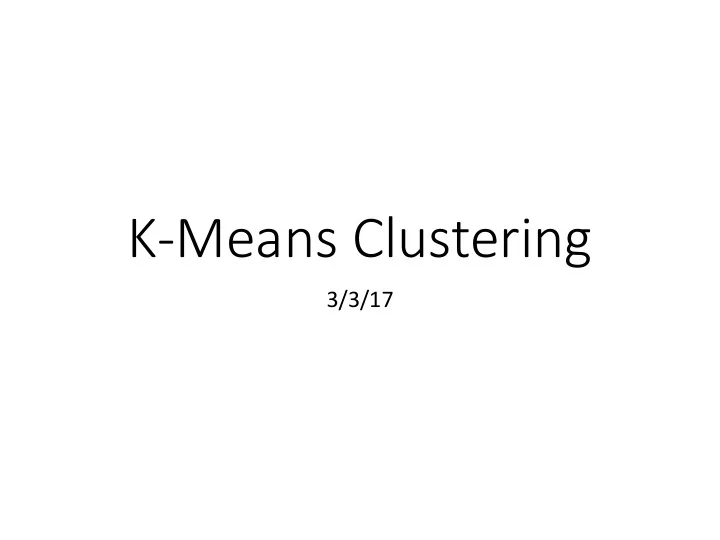

K-Means Clustering 3/3/17
Unsupervised Learning • We have a collection of unlabeled data points. • We want to find underlying structure in the data. Examples: • Identify groups of similar data points. • Clustering • Find a better basis to represent the data. • Principal component analysis • Compress the data to a shorter representation. • Auto-encoders
Unsupervised Learning • We have a collection of unlabeled data points. • We want to find underlying structure in the data. Applications: • Generating the input representation for another AI or ML algorithm. • Clusters could lead to states in a state space search or MDP model. • A new basis could be the input to a classification or regression algorithm. • Making data easier to understand, by identifying what’s important and/or discarding what isn’t.
The Goal of Clustering Given a bunch of data, we want to come up with a representation that will simplify future reasoning. Key idea: group similar points into clusters. Examples: • Identifying objects in sensor data • Detecting communities in social networks • Constructing phylogenetic trees of species • Making recommendations from similar users
EM Algorithm E step: “expectation” … terrible name • Classify the data using the current model. M step: “maximization” … slightly less terrible name • Generate the best model using the current classification of the data. Initialize the model, then alternate E and M steps until convergence. Note: The EM algorithm has many variations, including some that have nothing to do with clustering.
K-Means Algorithm Model: k clusters each represented by a centroid. E step: • Assign each point to the closest centroid. M step: • Move each centroid to the mean of the points assigned to it. Convergence: we ran an E step where no points had their assignment changed.
K-Means Example
Initializing K-Means Reasonable options: 1. Start with a random E step. • Randomly assign each point to a cluster in {1, 2, …, k}. 2. Start with a random M step. a) Pick random centroids within the maximum range of the data. b) Pick random data points to use as initial centroids.
K-Means in Action https://www.youtube.com/watch?v=BVFG7fd1H30
Another EM Example: GMMs GMM: Gaussian mixture model • A Gaussian distribution is a multivariate generalization of a normal distribution (the classic bell curve). • A Gaussian mixture is a distribution comprised of several independent Gaussians. • If we model our data as a Gaussian mixture, we’re saying that each data point was a random draw from one of several Gaussian distributions (but we may not know which).
EM for Gaussian Mixture Models Model: data drawn from a mixture of k Gaussians E step: • Compute the (log) likelihood of the data • Each point’s probability of being drawn from each Gaussian. M step: • Update the mean and covariance of each Gaussian. • Weighted by how responsible that Gaussian was for each data point.
How do we pick K? There’s no hard rule. • Sometimes the application for which the clusters will be used dictates k. • If k can be flexible, then we need to consider the tradeoffs: • Higher k will always decrease the error (increase the likelihood). • Lower k will always produce a simpler model.
Hierarchical Clustering • Organizes data points into a hierarchy. • Every level of the binary tree splits the points into two subsets. • Points in a subset should be more similar than points in different subsets. • The resulting clustering can be represented by a dendrogram.
Direction of Clustering Agglomerative (bottom-up) • Each point starts in its own cluster. • Repeatedly merge the two most-similar clusters until only one remains. Divisive (top-down) • All points start in a single cluster. • Repeatedly split the data into the two most self-similar subsets. Either version can stop early if a specific number of clusters is desired.
Recommend
More recommend